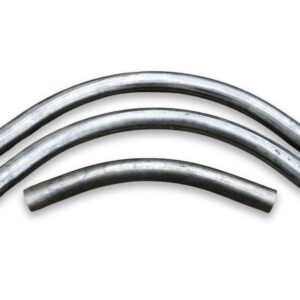Component wear is one of the most common and disruptive problems in pneumatic conveying. As wear increases, so too does the risk of problems like shredding, streamers, contamination, friability, corrosion, erosion, blocking and dusting, and pile and bulking. These then require significant downtime and maintenance costs to fix, seriously impacting your productivity and bottom line.
Not all wear is the same, however. In fact, there are three main types that manufacturers need to be aware of and know how to recognize. By identifying and addressing wear in your pneumatic conveying system, you can increase uptime, boost profitability, and reduce your expenses with ease.
Impact wear
Impact wear occurs when materials traveling at a high velocity strike the insides of your pneumatic conveying system. The bends and elbows in your pneumatic conveying system are most likely to experience impact wear, especially if they appear at the end of a long stretch of straight pipe. Short-radius bends in particular tend to suffer much more severe impact wear because of the sharp angle of impact.
This type of wear usually appears in a single spot. It presents as a hole or dent right at or just off of the tangential line where the material hits the back of the bend. This makes impact wear relatively easy to predict and monitor. However, materials that bounce can cause multiple – and unpredictable – points of impact wear throughout your system.
The speed of the bulk material and the pressure inside your pneumatic conveying system are key factors in determining the impact force of particles. Some impact damage is normal and expected. But if the force of impact is high enough, it can cause larger particles of material to break and shatter. And the stronger and more frequent the impacts, the quicker your components will wear out.
How to manage impact wear in pneumatic conveying systems
The most reliable way to protect against impact wear in your pneumatic conveying system is to reduce the energy or pressure of the conveying air. This will lower the speed of your materials within your pipelines, limiting the force of impact.
But depending on your material characteristics and operational needs, this might not be a viable solution. It could slow your production to the point where you can’t fulfill your goals, or even cause your materials to fall from the airstream and block your pipes. In these cases, you can combat impact wear effectively by investing in impact-resistant components.
With their high tensile strength and low susceptibility to brittleness, stainless steel bends are an excellent choice for high-impact applications. Although they’re generally more expensive than bends of other materials, they also tend to have a much longer lifespan. This makes them a valuable long-term investment that can lead to lower maintenance costs and higher product quality over time.
Abrasive wear (Sliding Abrasion)
Also called sliding abrasion, abrasive wear is caused by the friction created when materials drag along the inside of your pipes. While abrasive wear can occur throughout your system, it’s a particular problem in areas where particles change direction. This is why pneumatic conveying bends and elbows are at such a high risk of abrasive wear.
Unlike the fast and forceful damage of impact wear, abrasive wear degrades components over a longer period of time. It appears as a line of abrasion with a long, even pattern along the inside of system components.
Abrasive wear tends to be more pronounced in long-radius bends. That’s because products usually drag along the backs of these components rather than impacting a single point.
Different materials have different levels of abrasiveness. This is known as their friction coefficient. Steel, for example, has a higher friction coefficient than polyethylene. Understanding the friction coefficient of your materials will make it easier for you to predict and prevent abrasive wear.
How to manage abrasive wear in pneumatic conveying systems
Similar to impact wear, it’s possible to reduce abrasive wear by adjusting the velocity and pressure within your system. But when this isn’t possible, you can swap out your existing components with those specifically designed to resist abrasion.
Carbon steel bends are one of the most durable and abrasion-resistant options available. The presence of carbon makes them around 2.5x denser than aluminum, meaning they can be made quite thin without sacrificing performance. This also tends to make carbon steel bends cheaper than other options, extending your system lifespan in abrasive applications while also reducing downtime and maintenance costs.
Corrosive wear
Of the three main types of wear in pneumatic conveying systems, corrosive wear is the least common. It typically occurs when conveying chemicals, but some dry bulk materials can also cause corrosion. For example, the sap produced by wood chippings can be corrosive, wearing away at plain steel components over time.
Whereas impact and abrasive wear develop most commonly in bends and elbows, corrosive wear can appear wherever your corrosive materials contact your pipes. This can cause cracks and leaks within your pneumatic conveying pipes, and can also discolor your end product.
How to manage corrosive wear in pneumatic conveying systems
Recalibrating your system will do nothing to address corrosive wear in your system. In this case, the only long-term solution is to install corrosion-resistant components.
Stainless steel components are highly effective in corrosive applications. They don’t corrode or rust except in the most extreme acidic or base environments, and they don’t require additional coating or painting to maintain their integrity.
Protect your system against wear with high-quality bends
The type of material you choose for your pneumatic conveying components has a profound effect on your system’s ability to resist wear. That’s why we supply manufacturers nationally and internationally with durable, reliable, and cost-effective pneumatic conveying bends in stainless steel, carbon steel, and aluminum.
As the world’s first online pneumatic conveying retailer, PneuComponents allows you to quickly order custom components with no long sales call required. Just select your preferred material, pick your specifications, and add to cart. And if you need components in dimensions we don’t typically stock, we can custom manufacture them for you on request.
Visit our online store now for long-lasting pneumatic conveying bends that consistently protect your system against wear.
As a part of Progressive Products, Inc, PneuComponents draws on over 40 years of technical expertise and industry innovation to give you the best possible guidance and service. Progressive Products is an industry-leading manufacturer of abrasion-resistant components, and their products are used in pneumatic conveying systems worldwide.
-
Stainless Steel Bends$54.42 – $376.47
-
Carbon Steel Bends$22.83 – $198.45
-
Aluminum Bends$16.57 – $124.62



